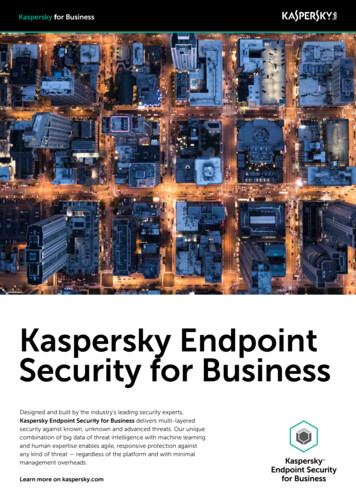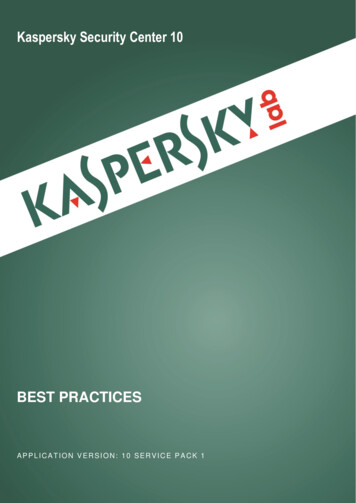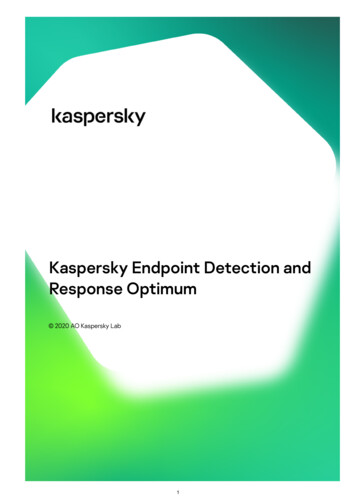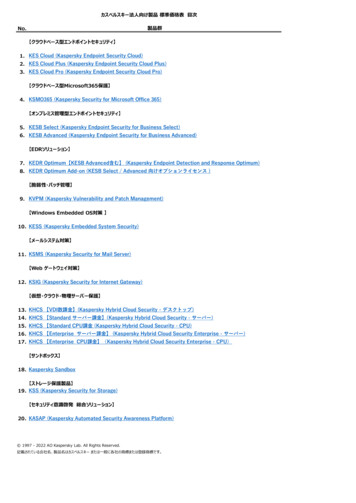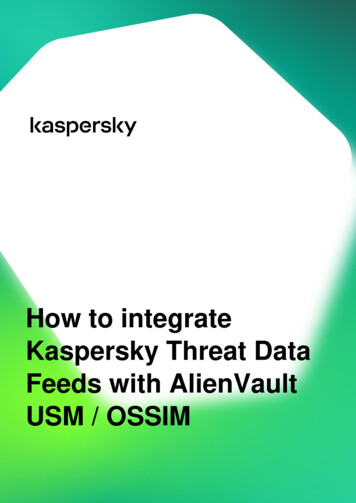
Transcription
How to integrateKaspersky Threat DataFeeds with AlienVaultUSM / OSSIM
Dear User,Thank you for choosing Kaspersky as your security software provider. We hope that this document will help you touse our product.Attention! This document is the property of AO Kaspersky Lab (herein also referred to as Kaspersky): all rights to thisdocument are reserved by the copyright laws of the Russian Federation and by international treaties. Illegalreproduction and distribution of this document or parts hereof incur civil, administrative, or criminal liability underapplicable law.Any type of reproduction or distribution of any materials, including translations, is allowed only with the writtenpermission of Kaspersky.This document, and graphic images related to it, may be used for informational, non-commercial, and personalpurposes only.Kaspersky reserves the right to amend this document without additional notification.Kaspersky assumes no liability for the content, quality, relevance, or accuracy of any materials used in this documentto which rights are held by third parties, or for any potential harms associated with use of the document.Document revision date: 04.10.2019 2019 AO Kaspersky Lab. All Rights persky.comhttps://support.kaspersky.com
ContentsAbout this document . 4How to integrate Kaspersky Threat Data Feeds with AlienVault USM / OSSIM using Kaspersky CyberTrace . 5Configuring Kaspersky CyberTrace for integration with AlienVault USM / OSSIM . 5Forwarding events from AlienVault USM / OSSIM to Kaspersky CyberTrace . 6Importing configuration files in AlienVault USM / OSSIM . 7Browsing events from Kaspersky CyberTrace in AlienVault USM / OSSIM . 10AO Kaspersky Lab . 12Contents3
About this documentThis document contains instructions for integrating Kaspersky Threat Data Feeds with AlienVault USM (or AlienVaultOSSIM).We recommend that you integrate Kaspersky Threat Data Feeds with AlienVault USM / OSSIM by using KasperskyCyberTrace. Kaspersky CyberTrace offers the following features: Automatic high-performance matching of incoming logs and events with Kaspersky Threat Data Feeds,OSINT feeds, and any other custom feeds in the most popular formats (JSON, STIX , XML, CSV). Demofeeds from Kaspersky and OSINT are available immediately upon installation of Kaspersky CyberTrace. Internalized process of parsing and matching incoming data reduces SIEM solution load significantly.Kaspersky CyberTrace parses incoming logs and events, matches the resulting data to feeds, and generatesits own alerts when threats are detected. Consequently, a SIEM solution processes less data. Generates feed usage statistics for measuring the effectiveness of feeds. In-depth threat investigation through on-demand lookup of indicators (hashes, IP addresses, domains,URLs). Bulk scanning of logs and files is also supported. Universal approach to integration of threat matching capabilities with SIEM solutions and other securitycontrols. SIEM connectors for a wide range of SIEM solutions can be used to visualize and manage dataabout threat detections. IoC and related context are efficiently stored in RAM for rapid access and filtering. Kaspersky CyberTrace Web, a web user interface for Kaspersky CyberTrace, provides data visualization,on-demand IoC lookup functionality, and access to Kaspersky CyberTrace configuration. KasperskyCyberTrace Web also supports the management of feeds, log parsing rules, black lists and white lists, andevent sources. Command-line interface for Windows and Linux platforms. Advanced filtering for feeds and log events. Feeds can be converted and filtered based on a broad set ofcriteria such as time, popularity, geographical location, and threat type. Log events can be filtered based oncustom conditions. DMZ integration support. The computer on which event data is matched against feeds can be located in theDMZ and isolated from the Internet. In standalone mode, where Kaspersky CyberTrace is not integrated with a SIEM solution, KasperskyCyberTrace receives logs from various sources such as networking devices and parses these logs accordingto defined regular expressions. Export lookup results that match feeds to CSV format for integration with other systems (firewalls, networkand host IDS, or custom tools).About this document4
How to integrate Kaspersky ThreatData Feeds with AlienVault USM /OSSIM using Kaspersky CyberTraceIntegration of Kaspersky Threat Data Feeds with AlienVault USM / OSSIM involves the following steps:1. Configuration of Kaspersky CyberTrace for integration with AlienVault USM / OSSIM (see section"Configuring Kaspersky CyberTrace for integration with AlienVault USM / OSSIM" on page 5).2. Configuration of AlienVault USM / OSSIM for forwarding events to Kaspersky CyberTrace (see section"Forwarding events from AlienVault USM / OSSIM to Kaspersky CyberTrace" on page 6).3. Adding a Kaspersky CyberTrace event source to AlienVault USM / OSSIM (see section "Importingconfiguration files in AlienVault USM / OSSIM" on page 7).After integration, you can browse events from Kaspersky CyberTrace in AlienVault USM / OSSIM (see section"Browsing events from Kaspersky CyberTrace in AlienVault USM / OSSIM" on page 10).In this chapterConfiguring Kaspersky CyberTrace for integration with AlienVault USM / OSSIM . 5Forwarding events from AlienVault USM / OSSIM to Kaspersky CyberTrace . 6Importing configuration files in AlienVault USM / OSSIM . 7Browsing events from Kaspersky CyberTrace in AlienVault USM / OSSIM . 10Configuring Kaspersky CyberTrace for integration withAlienVault USM / OSSIMThis section describes how to configure Kaspersky CyberTrace for integration with AlienVault USM / OSSIM. Youcan use any version of Kaspersky CyberTrace available at https://support.kaspersky.com/13858.Kaspersky CyberTrace and the device (proxy server, or firewall, or IDS, or AV, etc.) whose events will beforwarded to Kaspersky CyberTrace must work on different computers. Forwarding rules are based on IPaddresses. Therefore, the IP address of the computer where Kaspersky CyberTrace is installed must bedifferent from the IP addresses of the devices whose events have to be forwarded to Kaspersky CyberTrace. To configure Kaspersky CyberTrace for integration with AlienVault USM / OSSIM:1. Install Kaspersky CyberTrace as described athttps://click.kaspersky.com/?hl en-US&link online help&pid CyberTrace&version 1.0&helpid 162489. In Linux, the installation directory is /opt/kaspersky/ktfs. In Windows, the installation directory is %CyberTrace installDir%.How to integrate Kaspersky Threat Data Feeds with AlienVault USM / OSSIM using Kaspersky CyberTrace5
2. Configure Kaspersky CyberTrace by using Kaspersky CyberTrace Web (recommended) or by editing thekl feed service.conf configuration file (see information athttps://click.kaspersky.com/?hl en-US&link online help&pid CyberTrace&version 1.0&helpid 171625).Specify the following Kaspersky CyberTrace settings: IP address of the computer on which AlienVault USM / OSSIM runs, and port 514.These are the IP address and port on which Kaspersky CyberTrace sends detection events. IP address of the computer on which Kaspersky CyberTrace works, and any available port (for example,9999)These are the IP address and port to which AlienVault USM / OSSIM sends events for checking. This isthe port that Kaspersky CyberTrace listens on for incoming events. Service event format as follows:alert %Alert% context %RecordContext% Detection event format as follows:category %Category% detected %MatchedIndicator% url %RE URL%src %SRC IP% ip %RE IP% hash %RE MD5% context %RecordContext%3. In the kl feed service.conf file, set the enabled attribute of the OutputSettings FinishedEventFormat element to false.4. Save the kl feed service.conf file.5. Restart Kaspersky CyberTrace by using Kaspersky CyberTrace Web or the kl feed service script.Forwarding events from AlienVault USM / OSSIM toKaspersky CyberTraceThis section describes how to configure AlienVault USM / OSSIM for forwarding events to Kaspersky CyberTrace. To configure AlienVault USM / OSSIM for forwarding events to Kaspersky CyberTrace:1. For every device from which you want to forward events to Kaspersky CyberTrace, add the following rule tothe /etc/rsyslog.conf file:if ( fromhost-ip '%DEVICE IP%') then {action (type "omfwd"Target "%CyberTrace IP IN%" Port "%CyberTrace PORT IN%" Protocol "tcp"Device "%INTERFACE%") action (type "omfile" File "%PATH%")}Here: %CyberTrace IP IN%—IP address of the computer on which Kaspersky CyberTrace runs. %CyberTrace PORT IN%—Port that Kaspersky CyberTrace listens on for incoming events. %INTERFACE%—Name of the network interface of the computer on which AlienVault USM / OSSIMruns, which will be used for forwarding events to Kaspersky CyberTrace.For example, eth0. %DEVICE IP%—IP address of the device from which events arrive at AlienVault USM/OSSIM and mustHow to integrate Kaspersky Threat Data Feeds with AlienVault USM / OSSIM using Kaspersky CyberTrace6
be forwarded to Kaspersky CyberTrace. action (type "omfile" File "%PATH%")—Instructions for the rsyslog service to store thoseevents in AlienVault USM / OSSIM that are forwarded to Kaspersky CyberTrace.%PATH%— Path to the file in which the events will be stored. %PATH% can be any file where you want tostore the forwarded events.action (type "omfile" File "%PATH%")—Optional. You can specify this command duringthe integration process in order to check the following: The fact that events are forwarding to Kaspersky CyberTrace List of the events that are being forwarded to Kaspersky CyberTraceWhen the integration process is finished, it is recommended to remove this line from the configurationfile.This rule must be added after the text # rsyslog zasec.conf. If this text is not present in theconfiguration file, add the rule before the following lines:if not ( fromhost-ip '127.0.0.1') then -/var/log/ossim/asec unk.logif not ( fromhost-ip '127.0.0.1') then 2. Restart the rsyslog service by running the following command:/etc/init.d/rsyslog restartImporting configuration files in AlienVault USM / OSSIMThis section describes how to configure AlienVault USM / OSSIM for treating Kaspersky CyberTrace as an eventsource. To configure AlienVault USM / OSSIM for this purpose, make sure to perform the following procedure on thecomputer on which AlienVault USM / OSSIM runs. To configure AlienVault USM / OSSIM for receiving events from Kaspersky CyberTrace:1. Copy the following configuration files to their target directories: Copy kaspersky cyberTrace.cfg to the /etc/ossim/agent/plugins/ directory. Copy kaspersky cyberTrace.sql to the ry.The kaspersky cyberTrace.cfg and kaspersky cyberTrace.sql files are shipped together with this Helpdocumentation or are received from your technical account manager (TAM).2. Add the following rule to the /etc/rsyslog.conf file:if ( fromhost-ip '%CyberTrace IP OUT%') then-/var/log/kaspersky cyberTrace.logHere %CyberTrace IP OUT% is the IP address of the computer from which Kaspersky CyberTracesends events.3. Run the following command:cat ky cyberTrace.sql ossim-dbHow to integrate Kaspersky Threat Data Feeds with AlienVault USM / OSSIM using Kaspersky CyberTrace7
This command adds information about Kaspersky CyberTrace to the AlienVault database.4. Restart the rsyslog service by running the following command:/etc/init.d/rsyslog restart5. In the AlienVault USM / OSSIM web interface, select Configuration Deployment Components AlienVault Center.6. In the AlienVault Components Information section, select a USM Appliance Sensor that will receiveevents from CyberTrace.7. Select Sensor Configuration Collection.8. Find the kaspersky cyberTrace plugin in the Plugins available list and click the button.Picture 1: Choosing the Kaspersky cyberTrace plugin9. Click Apply Changes.10. Configure the logrotate utility to archive Kaspersky CyberTrace events on the computer on whichAlienVault USM / OSSIM runs:1. Create the kaspersky cybertrace file in the /etc/logrotate.d directory.2. In the kaspersky cybertrace file, specify the following lines:/var/log/kaspersky cyberTrace.log{# save 3 months of logsrotate w to integrate Kaspersky Threat Data Feeds with AlienVault USM / OSSIM using Kaspersky CyberTrace8
sharedscripts# run a script after log rotationpostrotateinvoke-rc.d rsyslog rotate /dev/nullendscript}3. Save and close the kaspersky cybertrace file.If you want to save logs for another period, see the logrotate documentation to configure thekaspersky cybertrace file.After you perform this procedure, Kaspersky CyberTrace device will be added to AlienVault USM / OSSIM. Forexample, on the Configuration Threat Intelligence Data Source page of the AlienVault USM / OSSIM webinterface, you will find Kaspersky CyberTrace in the list of data sources.The rsyslog service will store events from Kaspersky CyberTrace in the/var/log/kaspersky cyberTrace.log file.After you configure Kaspersky CyberTrace and AlienVault USM / OSSIM, perform the verification test as described athttps://click.kaspersky.com/?hl en-US&link online help&pid CyberTrace&version 1.0&helpid 171415. For this,send the verification test events to Kaspersky CyberTrace by using the Log Scanner utility (which is part of KasperskyCyberTrace). The verification test events are contained in theverification/kl verification test.txt file. Check the verification test result in the AlienVault USM /OSSIM web interface (see section "Browsing events from Kaspersky CyberTrace in AlienVault USM / OSSIM" onpage 10).By default, every detection event, for each Kaspersky Threat Data Feed, has its own type in AlienVault. Detectionevents for other feeds, for example, OSINT feeds, have the Kaspersky CyberTrace - Detection eventvalue in the event name field.You can rename the detection events of the imported feeds in order to classify the detection events according to theircategories. To rename the detection events of the imported feed:1. Add the following line to the translation section of the/etc/ossim/agent/plugins/kaspersky cyberTrace.cfg configuration file:%CATEGORY ATTRIBUTE VALUE OF THE IMPORTED FEED% %ANY FREE NUMERIC VALUE%where %CATEGORY ATTRIBUTE VALUE OF THE IMPORTED FEED% is the value of the categoryattribute of the imported feed from kl feed service.conf. For example: Custom Feed 50.2. Save and close the file.3. Add the following line before the last line of ersky cyberTrace.sql file:(23021992, %NUMERIC VALUE SPECIFIED AT THE kaspersky cyberTrace.cfg%,15, 71, NULL, 'Kaspersky CyberTrace - %NAME TO REPLACE%', 5, 8),How to integrate Kaspersky Threat Data Feeds with AlienVault USM / OSSIM using Kaspersky CyberTrace9
4. Save and close the file.5. Run the following commands:cat ky cyberTrace.sql ossim-db/etc/init.d/ossim-agent restart/etc/init.d/ossim-server restartBrowsing events from Kaspersky CyberTrace in AlienVaultUSM / OSSIMThis section describes how to browse events from Kaspersky CyberTrace in AlienVault USM / OSSIM. To browse events from Kaspersky CyberTrace in the AlienVault USM / OSSIM web interface:1. In a browser, open the AlienVault USM / OSSIM web interface.2. Select Analysis Security events (SIEM).3. In the Data Sources drop-down list, select Kaspersky CyberTrace.AlienVault USM / OSSIM displays events received from Kaspersky CyberTrace.Picture 2: Events received from Kaspersky CyberTraceHow to integrate Kaspersky Threat Data Feeds with AlienVault USM / OSSIM using Kaspersky CyberTrace10
AlienVault USM / OSSIM displays Kaspersky CyberTrace events of two types, which are designated in the EventName column of the event list: Service eventsClick the button in the last column of the table (shown in the figure below). ). For service events, the following data is displayed (as The Userdata1 field contains the service event itself. The Userdata2 field contains the context of the event, if any.Detection eventsClick the button in the last column of the table (shown in the figure below).). For detection events, the following data is displayed (as The Userdata1 field contains the feed that is involved in the detection process. The Userdata2 field contains the detected indicator. The Userdata3 field contains the context of the feed record that is involved in the detection process.The Userdata3 field contains up to 1024 symbols, so it may not contain the whole context. The wholeevent (including the context) is contained in the RAW LOG field.Picture 3: Detection event dataHow to integrate Kaspersky Threat Data Feeds with AlienVault USM / OSSIM using Kaspersky CyberTrace11
AO Kaspersky LabKaspersky is a world-renowned vendor of systems protecting computers against digital threats, including viruses andother malware, unsolicited email (spam), and network and hacking attacks.In 2008, Kaspersky was rated among the world’s top four leading vendors of information security software solutionsfor end users (IDC Worldwide Endpoint Security Revenue by Vendor). Kaspersky is the preferred vendor of computerprotection systems for home users in Russia (IDC Endpoint Tracker 2014).Kaspersky was founded in Russia in 1997. It has since grown into an international group of companies with 38 officesin 33 countries. The company employs more than 3,000 skilled professionals.Products. Kaspersky products provide protection for all systems, from home computers to large corporate networks.The personal product range includes security applications for desktop, laptop, and tablet computers, smartphonesand other mobile devices.The company offers protection and control solutions and technologies for workstations and mobile devices, virtualmachines, file and web servers, mail gateways, and firewalls. The company's portfolio also features specializedproducts providing protection against DDoS attacks, protection for industrial control systems, and prevention offinancial fraud. Used in conjunction with centralized management tools, these solutions ensure effective automatedprotection for companies and organizations of any size against computer threats. Kaspersky products are certified bymajor test laboratories, compatible with software from diverse vendors, and optimized to run on many hardwareplatforms.Kaspersky virus analysts work around the clock. Every day they uncover hundreds of thousands of new computerthreats, create tools to detect and disinfect them, and include their signatures in databases used by Kasperskyapplications.Technologies. Many technologies that are now part and parcel of modern anti-virus tools were originally developedby Kaspersky. It is no coincidence that many other developers use the Kaspersky Anti-Virus engine in their products,including: Alcatel-Lucent, Alt-N, Asus, BAE Systems, Blue Coat, Check Point, Cisco Meraki, Clearswift, D-Link,Facebook, General Dynamics, H3C, Juniper Networks, Lenovo, Microsoft, NETGEAR, Openwave Messaging,Parallels, Qualcomm, Samsung, Stormshield, Toshiba, Trustwave, Vertu, and ZyXEL. Many of the company’sinnovative technologies are patented.Achievements. Over the years, Kaspersky has won hundreds of awards for its services in combating computerthreats. Following tests and research conducted by the reputed Austrian test laboratory AV-Comparatives in 2014,Kaspersky ranked among the top two vendors by the number of Advanced certificates earned and was ultimatelyawarded the Top Rated certificate. But Kaspersky main achievement is the loyalty of its users worldwide. Thecompany’s products and technologies protect more than 400 million users, and its corporate clients number morethan 270,000.Kaspersky website:https://www.kaspersky.comVirus encyclopedia:https://securelist.comKaspersky VirusDesk:https://virusdesk.kaspersky.com (for analyzing suspicious filesand websites)Kaspersky Community:https://community.kaspersky.comAO Kaspersky Lab12
5. In the AlienVault USM / OSSIM web interface, select Configuration Deployment Components AlienVault Center. 6. In the AlienVault Components Information section, select a USM Appliance Sensor that will receive events from CyberTrace. 7. Select Sensor Configuration Collection. 8.

![Kaspersky Antivirus 6.0.4.1424. Key File 18 [REPACK]](/img/59/maramon.jpg)
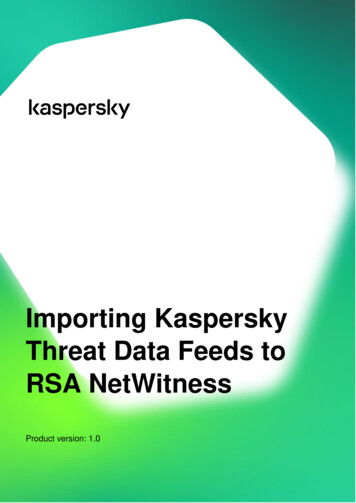



![Kaspersky Password Manager 9.0.1.447 Crack [BETTER]](/img/55/kaspersky-password-manager-901447-crack-better.jpg)
